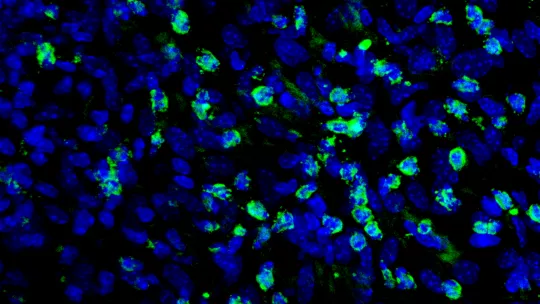Images
- The study, carried out by scientists from IRB Barcelona, Navarrabiomed, and the Institute of Neurosciences CSIC-UMH, has been published in Nature Metabolism.
- In 2022, 7,500 new cases of melanoma—the most aggressive type of skin cancer—were diagnosed in Spain.
Barcelona, 10 August 2023 – A collaborative study undertaken by IRB Barcelona (Barcelona), the Navarrabiomed Biomedical Research Center (Pamplona), and the Institute of Neurosciences CSIC-UMH (Sant Joan d’Alacant) shows that the administration of ranolazine, a drug currently used to treat heart conditions, improves the efficacy of current therapies for melanoma, in mouse models of this disease.
The journal Nature Metabolism has published the results of the study, which offers an alternative therapeutic approach to treat melanoma, the most deadly type of skin cancer, which affects 16.3 women and 14.6 men per 100,000 inhabitants in Spain.
The development of future clinical trials to validate and confirm the action of ranolazine in cancer patients will be facilitated by the fact that it has already been approved for use in humans and is being administered in clinical practice to treat chronic angina.
Details about the study
In most cases, patients with melanoma respond well to therapies directed against one of the key genes in tumour progression, namely BRAF. However, they soon develop resistance to these therapies and the tumours grow back. In addition, the latest clinical studies suggest that these patients show a poorer response to immunotherapy.
This study has provided a deeper understanding of the role of fatty acid metabolism in the development of resistance to BRAF inhibitors and demonstrated the capacity of ranolazine to slow down tumour progression. More importantly, this drug increases the visibility of melanoma cells to the immune system, thereby improving response to immunotherapies and increasing the ability of lymphocytes to control tumour growth.
Multicentre study
The research has been coordinated from Navarrabiomed by Dr. Imanol Arozarena Martinicorena, head of the Cancer Signaling Unit, and is part of the doctoral thesis by Marta Redondo Muñoz (Public University of Navarre), a researcher in the same unit.
The work has been carried out in close collaboration with the Institute of Neurosciences, involving Dr. Francisco Javier Rodríguez-Baena, under the direction of Dr. Berta Sánchez Laorden, principal investigator of the Cellular Plasticity in Development and Disease group, and with IRB Barcelona, where the ICREA researcher Dr. Salvador Aznar Benitah leads the Stem Cells and Cancer lab, as well as the translational laboratory Systemic Metabolic Alterations in Cancer.
Navarrabiomed has designed and managed the development of the project, and also carried out experiments related to resistance to targeted therapies and the study of how ranolazine affects the immunogenicity of melanoma cells.
“This study demonstrates that it is possible to pharmacologically reorganise the metabolism of the tumour cell to improve the effect of targeted therapies and immunotherapies. The next challenge is to demonstrate the clinical effect of these combinations in patients and study the potential of ranolazine in other types of cancer. To do this, we need to better understand how this drug acts both in tumour cells and in the immune system,” says Dr. Imanol Arozarena.
The Institute of Neurosciences CSIC-UMH (a joint centre of the CSIC and the Miguel Hernández University), conducted the immunotherapy trials with mice and the study of immune cells in the tumour microenvironment.
“Immunotherapy has established itself as a fundamental therapeutic strategy for melanoma and other types of cancer. Despite this, many patients do not respond optimally to these treatments. This work shows the beneficial impact of the combination of ranolazine with immunotherapy in preclinical models of melanoma, thus supporting its possible application in patients,” highlights Dr. Berta Sánchez-Laorden.
Scientists at IRB Barcelona performed single-cell RNA sequencing analyses, which have revealed in detail the effect of ranolazine on the metabolic state of tumour cells. “We suspected that fatty acid metabolism was crucial in the most aggressive forms of melanoma, but being able to confirm this with a drug already approved for use in humans is highly relevant. Hopefully, these results can pave the way to change clinical practice,” says Dr. Aznar Benitah.
Incidence of melanoma
In 2022, 7,500 new cases of skin melanoma were diagnosed in Spain. Worldwide, this type of cancer accounts for 3.4% of the total number of cancer cases detected. Despite accounting for only 10% of skin cancer cases, melanoma is responsible for 90% of deaths associated with skin tumours.
Thanks to the development of targeted therapies and immunotherapies, the clinical treatment of individuals with melanoma has improved, but 50% of patients are still unresponsive and/or acquire resistance to these therapies. The combination of current therapies with ranolazine would offer a therapeutic alternative for these patients, improving their clinical response.
The study has been funded through institutional support and resources granted by various organisations: the Spanish Ministry of Science and Innovation, the Carlos III Health Institute, the Government of Navarre, the Spanish Multidisciplinary Melanoma Group (GEM), and the Melanoma Research Alliance.
Dr. Aznar Benitah's laboratory is supported by the European Research Council (ERC) within the framework of the Horizon 2020 research and innovation programme of the European Union, the Government of Catalonia, the Spanish Ministry of Science and Innovation, the La Marató de TV3 Foundation, the Lilliane Bettencourt Foundation, the Spanish Association Against Cancer, and the Worldwide Cancer Research Fund (WCRF).
Related article:
Metabolic rewiring induced by ranolazine improves melanoma responses to targeted therapy and immunotherapy
Redondo-Muñoz M, Rodriguez-Baena FJ, Aldaz P, Caballé-Mestres A, Moncho-Amor V, Otaegi-Ugartemendia M, Carrasco-Garcia E, Olias-Arjona A, Lasheras-Otero I, Santamaria E, Bocanegra A, Chocarro L, Grier A, Dzieciatkowska M, Bigas C, Martin J, Urdiroz-Urricelqui U, Marzo F, Santamaria E, Kochan G, Escors D, Larrayoz IM, Heyn H, D’Alessandro A, Stephan-Otto Attolini C, Matheu A, Wellbrock C, Aznar Benitah S, Sanchez-Laorden B & Arozarena I
Nature Metabolism (2023) DOI: 10.1038/s42255-023-00861-4
About IRB Barcelona
The Institute for Research in Biomedicine (IRB Barcelona) pursues a society free of disease. To this end, it conducts multidisciplinary research of excellence to cure cancer and other diseases linked to ageing. It establishes technology transfer agreements with the pharmaceutical industry and major hospitals to bring research results closer to society, and organises a range of science outreach activities to engage the public in an open dialogue. IRB Barcelona is an international centre that hosts 400 researchers and more than 30 nationalities. Recognised as a Severo Ochoa Centre of Excellence since 2011, IRB Barcelona is a CERCA centre and member of the Barcelona Institute of Science and Technology (BIST).










